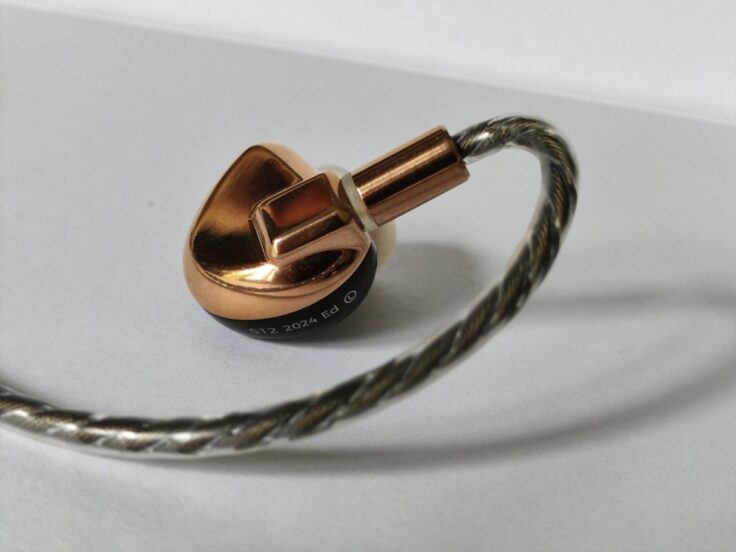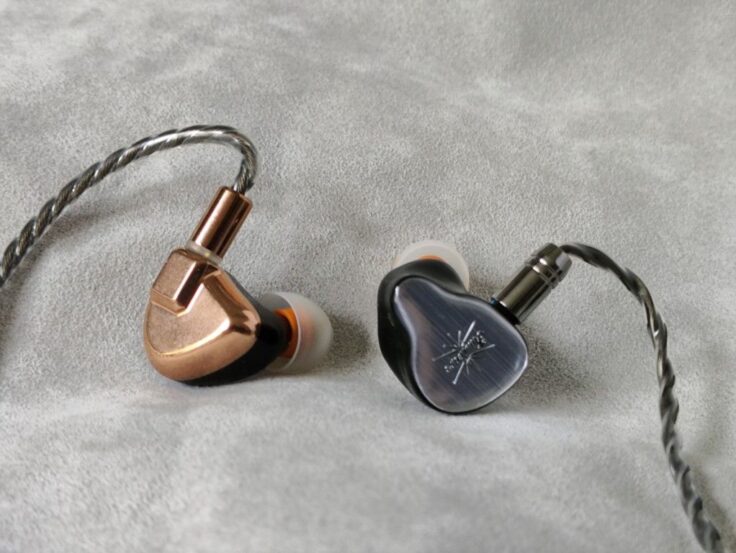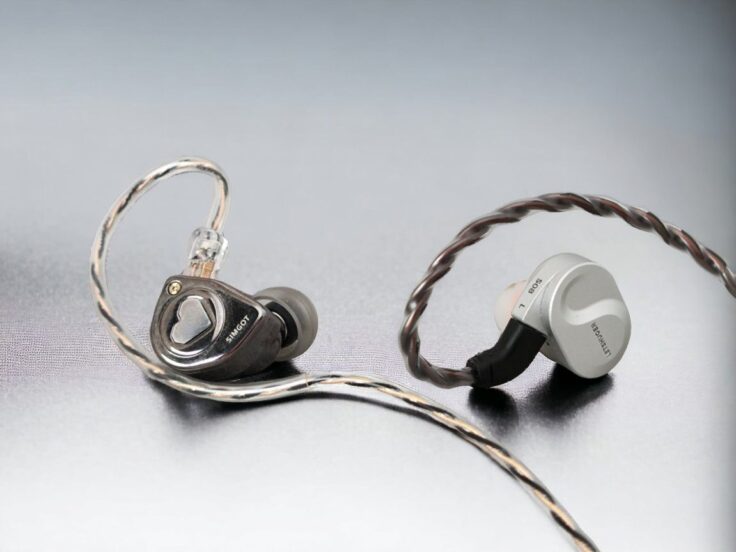The Letshuor S12 PRO has been a reference planar-magnetic IEM for several years. Featuring a substantial single 14.8mm planar-magnetic driver, it excels particularly in bass performance. Crafted from CNC-machined aluminum alloy, its housing is both compact and comfortable. Additionally, it comes with a high-quality cable equipped with exchangeable termination connectors (2.5, 3.5, 4.4mm)
The Letshuoer x Gizaudio Galileo has a meticulously designed resin housing with innovative resonance handling. It features a clean, well-balanced sound with impressive detail, featuring a 10mm dynamic driver with a silicon aluminium-magnesium coated diaphragm, and a Danish Sonion 2389 balanced armature driver.
Both the S12 PRO and the Galileo come with a high-quality silver-plated OFC wire with 0.78mm earphone connectors, making it suitable for third-party cables.
LETSHUOER x GIZAUDIO GALILEO SPECIFICATIONS
- Drivers: 1 Dynamic Driver, 1 Balanced Armature Driver
- Impedance: 14Ω
- Sensitivity: 104dB
- Frequency Response: 20Hz – 20KHz
- Cable Length: 1.2M
- Pin Type: 2-pin Connector (0.78MM)
- Plug Type: 3.5mm
- Housing: 3D printed medical-grade resin
- Tips included
Price when reviewed: 109 USD.
- Price on Amazon: Letshuoer x Gizaudio Galileo
- Price on Linsoul: Letshuoer x Gizaudio Galileo
LETSHOUR S12 PRO SPECIFICATIONS
- Driver: 14.8mm planar-magnetic driver
- Impedance: 16Ω±1Ω
- Sensitivity: 102dB
- Frequency Response: 20Hz – 20KHz
- Distortion: 0.5% ±0.1%
- Connector IEM: 0.78 dual pin
- Cable termination: 2.5mm / 3.5mm / 4.4mm swappable
- Cable: 392-strands silver plated monocrystalline copper
- Chassis material: Aluminum alloy
- Machining process: 5-axis CNC
Price when reviewed: 109 USD

COMPARISONS
Bergen Open by BMX
They both sound very detailed and spacious, with tight bass. I find that the Galileo sounds the most organic, with the most natural sounding timbre.
Jambi by Tool
What strikes me the most about the Galileo is how clean and well separated the vocals are. There is a lot of space surrounding the singer. The electric guitar is very textured, and the bass is very good, but I do not get the wall or sound feeling that I know I can get from other earphones.
When I switch to the S12 PRO, it becomes clear that it is one of the earphones that I think about in that regard. It does not have an unnaturally exaggerated bass, but it is extremely tight, and the whole presentation is more massive than with the Galileo. The vocals are not as well separated and natural-sounding, but on the whole, I prefer the S12 PRO here.
Smile by Pearl Jam
The Galileo is very natural-sounding, and it has lots of dynamics and punch as well. The detail level is high, and the vocals sound great.
The S12 PRO presents a somewhat darker and thicker sound, but at the same time, it is crisper and dryer. It has a lot of texture, but it’s not as easy-flowing as the Galileo. The S12 PRO struggles with Eddie Vedder’s “s”-es, occasionally becoming sibilant.
Almost Like the Blues by Leonard Cohen
Again, the Galileo is wonderfully well balanced, with a present bass, a spacious soundstage, and natural timbre.
With the S12 PRO the bass has a similar quantity. However, it is tighter and has more texture. The Galileo has better macrodynamics, while the S12 PRO presents the music with more focus on microdynamics and textures. I like both.
Black Crow by Cassandra Wilson
The S12 PRO sounds very good. It has this dry warmth, which reveals textures in the music in a very nice way.
The Galileo has a more organic sound and a more rounded presentation, while at the same time being more dynamic with bigger contrasts. I would say the Galileo is the most natural sounding with the best timbre, but both presentations are very nice. The midrange is more upfront sounding with the Galileo. The detail level is roughly similar in both, but they present detail differently.
Seahorse by Peter af Uggla
A fabulous-sounding acoustic steel guitar based track. The S12 PRO does a terrific job. The steel guitar is crisp and clear, the bass is full-bodied, and the presentation is really detailed and warm-sounding.
The Galileo is also very good. The two IEMs sound quite similar with this track. However, there’s a more organic feeling to the Galileo. It is highly detailed, with great soundstage and imaging, and the tonal balance is superb.
All For Us by Labrinth
The vocals are crystal clear, and the natural sounding is well separated with the Galileo. The bass is present and has a good texture, but it’s relatively polite in quantity.
With the S12 PRO, the bass is a lot more powerful. It is tight but full-bodied. The mids and vocals are more mellow than with the Galileo. The treble is slightly crisper.
Can’t You See, by Susan Wong
Also here, they are not very far apart. The S12 PRO has a nice dry warmth with crispness and texture. The Galileo is even more detailed but has got an organic type of warmth, with a bit more rounded and naturally voiced sound. Both are very enjoyable.
Winter 1 – Vivaldi 4 Seasons by The Norwegian Chamber Orchestra
The Galileo sounds very good, but there is something about the S12 PRO that really appeals with the strings in this piece. It is certainly more colored in a brighter and more textured way, but it is very enjoyable on this track.
Holberg Suite by 1B1
Here, the Galileo is truly stunning and sounds extremely organic and natural. The S12 PRO feels a bit off in comparison, slightly dry and crisp.

WRAPPING IT UP
Sound Signature
The Galileo is a quite neutral-sounding IEM. The S12 PRO has significantly more mid-bass and also less balanced high end, which can become a bit crisp.
Treble
The Galileo has a wonderfully well-balanced treble, is full of detail, and sounds extremely natural.
The S12 PRO is a bit rougher and has some edges. It can be very nice and crisp, but it can also become sibliant. I have never experienced that the Galileo becomes sibilant, so it’s a safer bet in that regard.
Midrange
The Galileo has an extremely organic and natural sounding midrange that is full of dynamics and detail. The S12 PRO is a bit more mellow and has more energy in the lower mids than in the higher. Together with the crisper treble, it has a dry warmth to the midrange, which is often very seductive but sometimes can be unnatural sounding.
Bass
The Galileo has an organic and natural presentation with good dynamics and detail.
However, when it comes to the lower regions, the S12 PRO is indeed the stronger contender, and it has a very satisfying bass performance. It has a boost in the mid-bass but does not exaggerate the deepest bass. It is very tight and controlled, living up to expectations as a planar-magnetic earphone.
Soundstage and Imaging
They both have a good, wide, and open soundstage. However, I find that the Galileo has better depth and more precise imaging and layering.
Detail, Dynamics and Timbre
Both have good detail and dynamics, but I find that the Galileo has the upper hand in this regard. Both in terms of macrodynamics and microdynamics, I find the Galileo to be a bit better, but that does not mean that the S12 PRO isn’t good.
With regards to timbre, the Galileo comes off as very natural and organic sounding, while the S12 PRO has more of a dry warmth with a more textured sounding timbre. The S12 PRO is a colored earphone, which makes it sometimes fantastic and sometimes a bit off.

CONCLUSION
Overall, the Letshuoer Galileo stands out for its neutral and natural sound signature, excellent detail retrieval, and precise imaging. On the other hand, the S12 PRO is a more colored earphone, with powerful and tight bass, mellow midrange, and textured timbre. It has a unique dry warmth to presentation, which often is very compelling.
The Galileo is my favorite, however, if your budget is up to it, there’s no good reason not to have both.







